New wolf snake species announced
MSc. Nguyen Van Tan (Duy Tan University, Da Nang) and international colleagues from the US, China, Russia, Myanmar and Germany have just announced the discovery and description of a new species of wolf snake, found in remote areas of China and Myanmar.
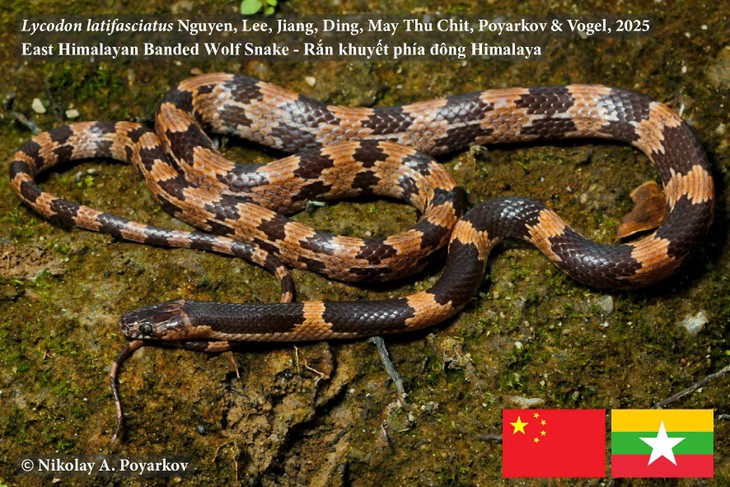 |
| New species of wolf snake Lycodon latifasciatus Nguyen, Lee, Jiang, Ding, May Thu Chit, Poyarkov & Vogel, 2025 (East Himalayan Banded Wolf Snake. Source: Nguyen et al. 2025). |
This discovery, published in the prestigious scientific journal Zootaxa, not only adds to Asia's growing biodiversity list but also highlights the important role of Vietnamese scientists in global biodiversity research.
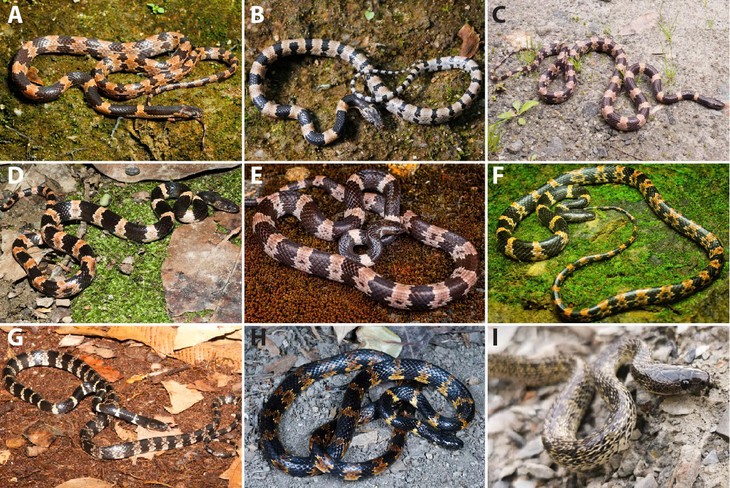 |
| Wild images of three wolf snake species: Lycodon latifasciatus (AC), L. fasciatus (DF) and L. fasciatus (GH) (Source: Nguyen et al. 2025). Source: Nguyen et al. 2025). |
Speaking to Knowledge and Life, MSc. Nguyen Van Tan (research leader and co-leader of the international research team in this project) said that the Eastern Himalayan Lycodon latifasciatus is medium in size, with the longest adult male recorded in the study having a total length of up to 871 mm.
The most striking and easily recognizable feature of this species is the pattern on its back. Broad dark brown horizontal bands stand out against a background of bright orange or orange-brown bands, creating a harmonious yet distinct overall appearance. This feature not only distinguishes it from L. fasciatus (which usually has a variable banding that can darken towards the back) and L. gongshan (which typically has a white or lighter reddish-brown band), but also inspired the scientific name "latifasciatus" (a combination of the Latin "latus" - wide and "fascia" - band).
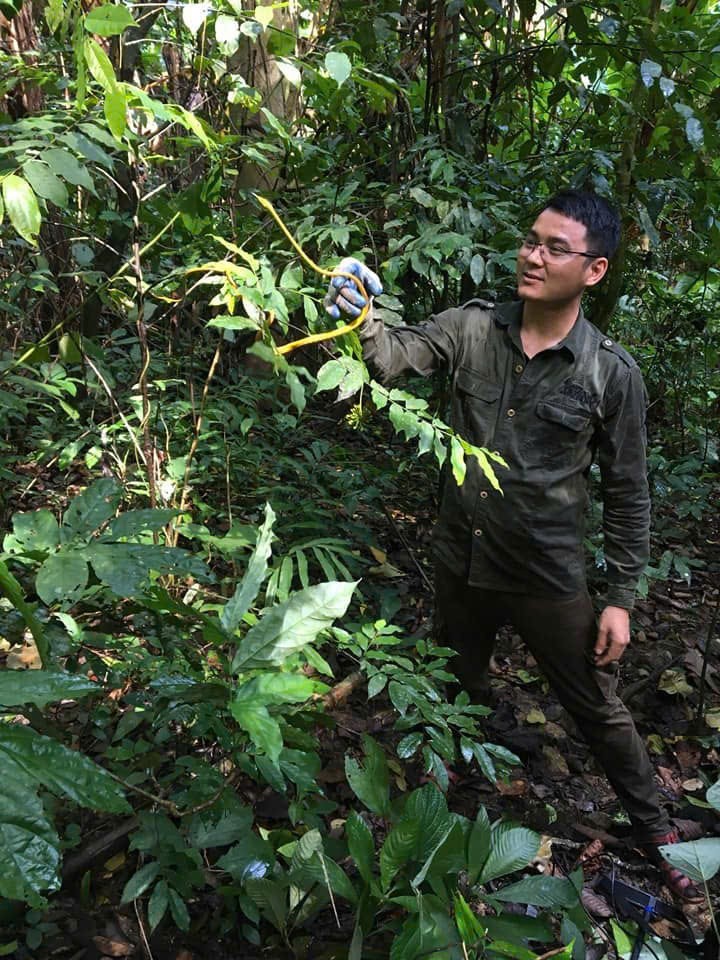 |
| MSc. Nguyen Van Tan (Duy Tan University, Da Nang), a scientist dedicated to discovering and describing a species of snake. Photo: NVCC. |
With these unique characteristics, the research team proposed the common name in English " East Himalayan Banded Wolf Snake ", which both describes the outstanding characteristics and indicates the preliminary geographical distribution area.
The research team, with analytical contributions from MSc. Tan, delved into morphological characteristics to strengthen the evidence of the new species. That is, the number of subcaudal scales (one of the most important quantitative differences) ranges from 90 to 96 scales. This number is significantly higher than the range of the Ringed Snake Lycodon fasciatus (74-90 scales).
Although there is some overlap at the upper limit with the gongshan Lycodon gongshan (79–96 scales), when combined with other characters it becomes a useful identifier. The total number of body scales (from ventral to subcaudal) also tends to be higher in the new species (297–312) than in L. fasciatus (278–302).
The new species typically has eight (rarely nine) upper labial scales, with the third, fourth, and fifth scales contacting the eye rim. The number of lower labial scales is typically eight or nine, and importantly, the first five lower labial scales typically contact the anterior pair of mental scales. This is statistically different from L. fasciatus (typically 9–10 lower labial scales) and L. gongshan (typically only four lower labial scales contact the anterior mental scales).
Belly and underside coloration: Unlike many Lycodon species that have a smooth belly or only distinct color bands, the posterior belly of L. latifasciatus often shows small, irregular black spots. The underside of the head of the new species is also distinctive: the dark pigmentation is mainly limited to the seams between scales, whereas in L. fasciatus and L. gongshan , the patches of black pigmentation are often more widespread, covering most of the lower labial and anterior chin scales.
The discovery of Lycodon latifasciatus was the result of extensive field surveys in the Tibet Autonomous Region (China) and Sagaing Region (Myanmar) by American and Chinese experts. The initial specimens collected in 2009 in Myanmar and subsequent specimens from Tibet (2015, 2017) and Myanmar (2019) initially puzzled scientists due to their superficial resemblance to known species.
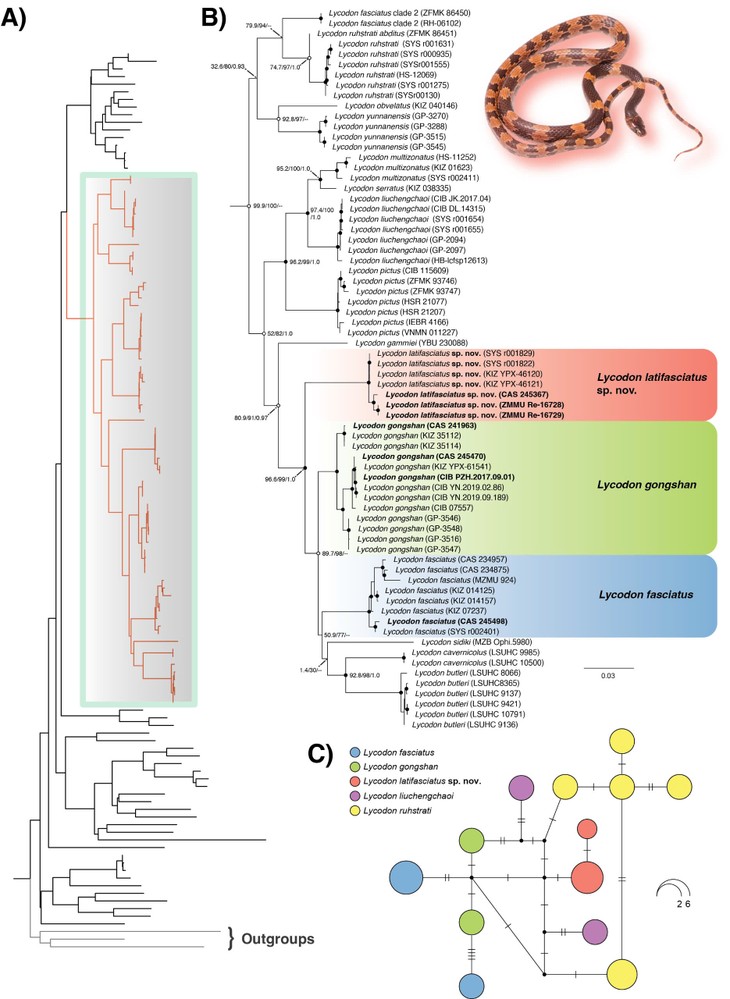 |
| Genetic relationships of snakes in the genus Lycodon (Source: Nguyen et al. 2025) |
However, the breakthrough came from molecular genetic analysis. MSc. Nguyen Van Tan and his team sequenced mitochondrial DNA (16S rRNA gene, cytochrome b) and nuclear DNA (RAG1 gene) from the specimens. Phylogenetic analysis showed that L. latifasciatus forms a distinct clade, an outgroup of a cluster of five other wolf snake species. The significant genetic distance (up to 12.94% in the cytochrome b gene) and the lack of haplotype sharing in the RAG1 gene provided strong evidence that this is a new, evolutionarily independent species.
Ecological context and conservation challenges
MSc. Tan said that based on collected data, Lycodon latifasciatus is currently known from three main locations, forming a distribution range extending from northern Myanmar up to the Tibet Autonomous Region of China. Their preferred habitat appears to be tropical evergreen and semi-deciduous forests at elevations ranging from 700 to 1500 m above sea level. Field records indicate that they are nocturnal and mainly terrestrial. Notably, at these locations, they coexist with at least one other snake species, Lycodon septentrionalis .
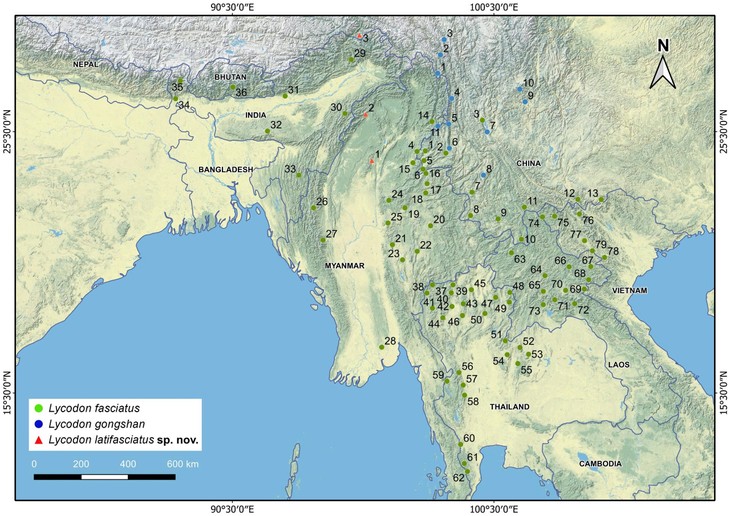 |
| Distribution map of three wolf snake species: Lycodon latifasciatus, L. gongshan and L. fasciatus (Source: Nguyen et al. 2025). |
Due to the lack of information, MSc. Nguyen Van Tan and the research team have cautiously proposed to classify the conservation status of L. latifasciatus as Data Deficient (DD) according to the IUCN Red List. The recommendation emphasizes the need to conduct more field studies and in-depth assessments in the future to be able to develop appropriate conservation strategies, ensuring the long-term survival of this unique snake species.
The scientific work of MSc. Nguyen Van Tan and his colleagues does not stop at describing a new species. It also provides an expanded and updated description of the morphology and distribution of Lycodon gongshan , confirms the existence of two distinct color forms, and records the species for the first time in Kachin State, Myanmar, as well as confirms previously controversial records in Sichuan, China. These revisions help clarify inconsistencies in previous scientific literature and provide a more solid foundation for future research.
According to MSc. Nguyen Van Tan, the process of identifying Lycodon latifasciatus is a typical example of perseverance in scientific research, lasting many years and requiring multinational cooperation. “The fact that Vietnamese scientists described new species in China and Myanmar is very rare in taxonomic research, demonstrating the extensive international cooperation of Vietnamese scientists,” MSc. Nguyen Van Tan emphasized.
According to MSc. Nguyen Van Tan, the process of identifying Lycodon latifasciatus is a typical example of perseverance in scientific research, lasting many years and requiring multinational cooperation. “The fact that Vietnamese scientists described new species in China and Myanmar is very rare in taxonomic research, demonstrating the extensive international cooperation of Vietnamese scientists,” MSc. Nguyen Van Tan emphasized.
Source: https://khoahocdoisong.vn/cong-bo-loai-ran-soi-moi-nha-khoa-hoc-viet-giai-ma-sao-post267743.html





![[Photo] National Assembly Chairman Tran Thanh Man attends the Party Congress of the Committee for Culture and Social Affairs](https://vphoto.vietnam.vn/thumb/1200x675/vietnam/resource/IMAGE/2025/5/11/f5ed02beb9404bca998a08b34ef255a6)




![[Video] Bringing environmental technology from the lab to life](https://vphoto.vietnam.vn/thumb/402x226/vietnam/resource/IMAGE/2025/5/11/57d930abeb6d4bfb93659e2cb6e22caf)
![[Video] Product risk classification: Solution to reform quality management, reduce burden for businesses](https://vphoto.vietnam.vn/thumb/402x226/vietnam/resource/IMAGE/2025/5/11/cbcd6b50805549a5bbb9e8e6354eda70)

![[Video] Domain name “.vn” - National symbol in cyberspace](https://vphoto.vietnam.vn/thumb/402x226/vietnam/resource/IMAGE/2025/5/11/ff459b2b640347a5948e3424e5c256d0)










![[Photo] National Assembly Chairman works with leaders of Can Tho city, Hau Giang and Soc Trang provinces](https://vphoto.vietnam.vn/thumb/1200x675/vietnam/resource/IMAGE/2025/5/11/c40b0aead4bd43c8ba1f48d2de40720e)
![[Photo] Discover the beautiful scenery of Wulingyuan in Zhangjiajie, China](https://vphoto.vietnam.vn/thumb/1200x675/vietnam/resource/IMAGE/2025/5/11/1207318fb0b0467fb0f5ea4869da5517)



































































Comment (0)